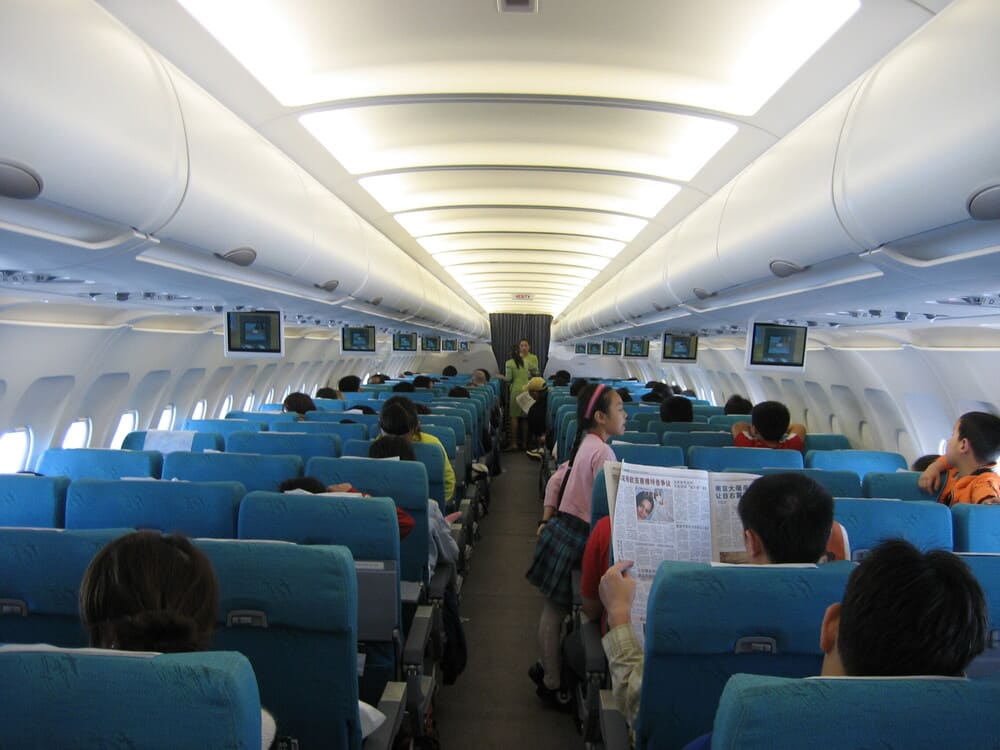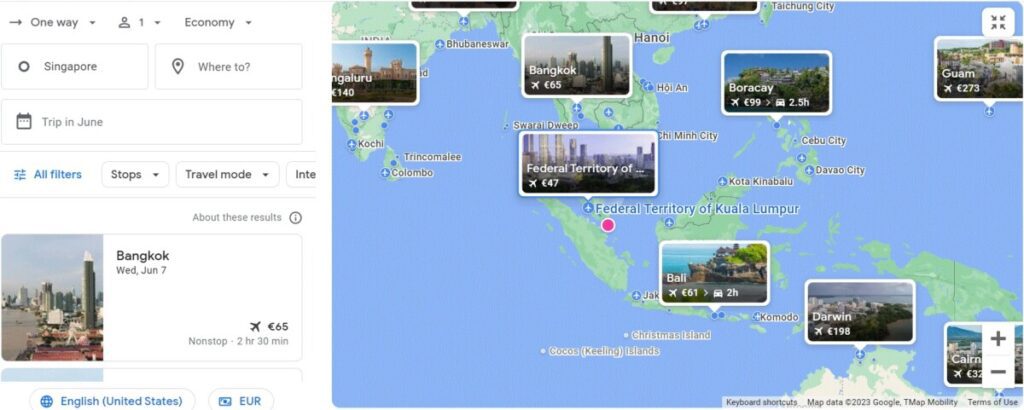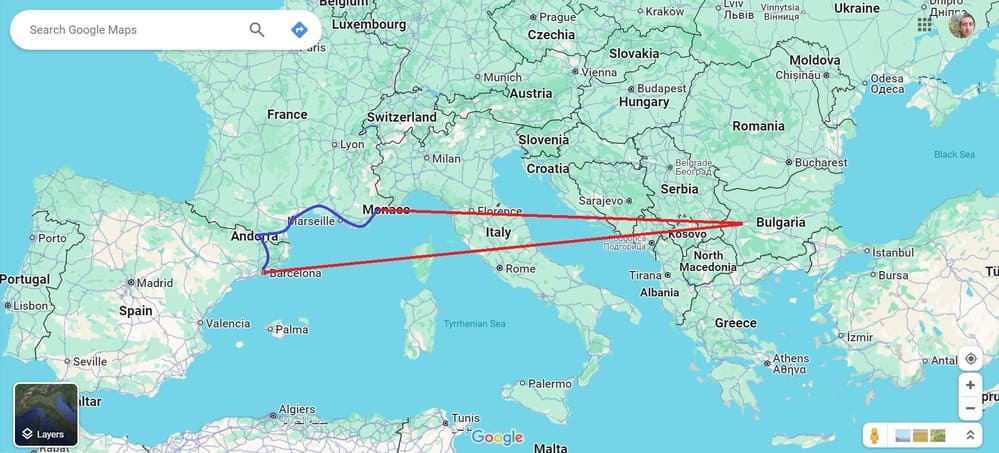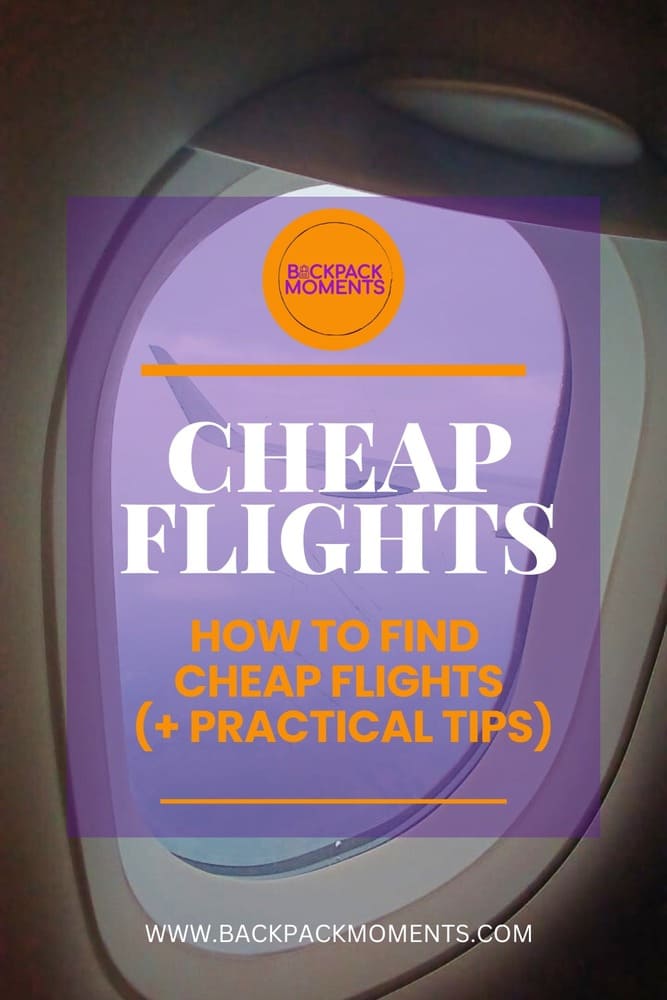How To Find Cheap Flights (+ Practical Tips)
This post may contain affiliate links. If you make a purchase using one of these links, I may receive a small reward at no extra cost to you. See my Disclosure Policy for more information.
If you’ve pledged not to fly – kudos! Our kids will thank you for having a livable planet!
Otherwise, you will need to book flights.
One of the most searched-for advice on the internet is about finding cheap flights. Not surprising, right? Flights are a massive chunk of any travel budget and reducing the money you spend on tickets, gives you more to spend on pleasant things like massages, coconuts, tours, and mango smoothies.

I consider myself a master of finding cheap flights.
Not humble, but I have the proof to back it up. Some of the bargains I’ve booked:
- A 12-hour flight from Asia to Europe for 147 USD.
- A 9-hour flight from Europe to Asia for 255 USD.
- A 7-hour flight from Central Asia to the Middle East for 37 USD.
- An 8-hour flight from Singapore to Australia for 140 USD.
- Many flights within Europe for 20 USD or less. Some as cheap as 5 USD.
- Many flights within Southeast Asia for as little as 12 USD.
Finding cheap flights is a complex process and a skill that takes real-life experience to master. There are no easy tricks or secret hacks, or at least I don’t consider them such.
But I will share my process, insights, and practical tips on how you, too, can spend less on flights!
The “price for convenience” trade-off
The more you’re willing to sacrifice convenience, the cheaper flights you can find.
It’s an inconvenient truth. Many want checked luggage, meals on board, complimentary lounge access, more leg space, short layovers, no red-eye flights, fewer connections, and other perks.
If you want to have all that, you have to pay for it. It’s the hard reality and it’s becoming ever more salient in today’s civil aviation industry as airlines strip their economy class of more and more benefits.

Many of the tips to follow assume you want to spend less on flights and are willing to endure less convenience. If that’s not you, perhaps you are not reading the right article.
Knowledge is power
Knowing the popular airports, low-cost airlines, and available routes helps a massive ton when searching for cheap flights.
Think about it: it’s easier to search for something you know of than for something you don’t. It’s an epistemological truth.
On the other hand, the airfare pricing algorithm is so complex, that nobody can claim to know exactly how it works. But here are a few basic things to keep in mind:
- We all know about budget airlines. They usually have lower fares than regular ones.
- Bigger airports generally have lower prices. They have a larger flight inventory leading to more competition. A BIG exception is cities with more than 1 airport – there, secondary airports have lower taxes and landing fees. In Europe, low-cost airlines utilize this every day.
- Some routes are cheaper than others, regardless of distance.

Some insights are gathered over the years and some you can figure out using flight search engines.
Flight Search Engines
If you already have a favorite flight search engine, keep using it. I believe there is little difference between the various websites and most have the same tools and access to the same flight databases.
I use Google Flights. I love its “Explore” function and the price graph (i.e. how the price has changed) for individual flights.

But other websites offer similar functionalities and some people swear by them. Here are the best ones:
Probably the most recognizable flight aggregation website.
It’s easy to use, has a ton of options, and allows you to book directly with them, sometimes cheaper than with the airline.
Skyscanner also has the Explore function, making it easier than ever to find cheap flight deals.
Kiwi’s Nomad function is unique as it allows you to add multiple destinations and watch as the algorithm shuffles all the possible ways you can get there and between them.
It’s a handy tool to research for backpackers flexible with their travel plans.
This innovative flight search engine finds you the best flight deals and gives you cashback.
And who doesn’t like cashback?
Momondo, Kayak, Expedia, and Booking also have their own flight search engines too.
Search functionalities
Flight search engines offer many functionalities but I few I love are:
- Reverse searching: Pick a destination as an origin to find possible cheap routes. The reverse route isn’t necessarily the same price (sometimes it isn’t even in the same ballpark) but this allows you to see what flies where.
- Anywhere: Pick an origin but set the destination to “anywhere” to get shown a map of all the destinations. This lets you narrow down routes that are within your budget. Very useful for nomads and long-term travelers. This is the same as the “Explore” function.
- Future prices at a glance: Once you choose a route, the engine shows you the prices for the next couple of months. Take these with a pinch of salt as they are the cheapest but often impractical (e.g. self-transfer in a country where you need a visa).
- Historic prices: When you select a particular flight, you can see how the price has changed over the past months. You can then extrapolate this for future flights and get an idea of the best time to book.
Why the “Explore” function is so great

The Explore function lets you see different flight routes at a glance. Just pick a starting point and a range of dates and watch as the map populates with popular destinations and their price.
Then, you can add more filters like only non-stop flights, precise destinations, or a price limit.
- Zoom out and the map will adjust to show you longer flights.
- Zoom in and you’ll see more regional flights.
Click on a flight to find out which companies fly the route and how the price has changed in the past few weeks.
Most search engines and flight aggregators today have some form of an Explore function but I love Google Flights for its simplicity.
Two flights are cheaper than one!
Did you know that often 2 flights with a connection are often cheaper than either of the two? This doesn’t intuitively make sense but is not losing the airlines money. It’s because people naturally avoid layovers so lower demand leads to lower prices (a massive oversimplification but you get the gist).
For example, a couple of years ago I flew from Muscat, Oman to Jakarta, Indonesia with a 5-hour layover in Abu Dhabi, UAE. I paid less than the price of the same flight from Abu Dhabi to Jakarta.


You may ask what good that is if you need to fly from Abu Dhabi specifically. Fair point. To make this work for you, you must be flexible. In this example, this is a wonderful opportunity to add a short trip to Oman to your plan before flying off to your final destination.
And just knowing this fact can sometimes be helpful too. You can add nearby airports to your search and compare prices.
Important note: Most low-cost carriers (LCCs) usually do NOT work this way because they do not have guaranteed layovers.
In other words, they only offer point-to-point flights and if you buy 2 “connecting” flights, the transfer is not protected and is your responsibility.
Book direct (or know the consequences)
I mostly book directly from the website of the airline I’ve picked. This is usually also the cheapest way, but not always.
Resellers sometimes offer cheaper prices for the exact same tickets. This may seem impossible and smell like a scam but isn’t. Online travel agencies (OTC) have signed deals with airlines to reserve a huge chunk of seats (called “inventory”) and thus get them for less than individual direct buyers.
It’s not a scam – you may pay less when you book through an OTC but you must know the fine print.
Not only do the airline’s rules still apply to you but for all queries, you must go through the OTC for help. In the event of delays or cancellations, you will receive support from the airline last (if at all) – you must liaise with the OTC first.
You can understand now why so many travelers who have bought a ticket through an OTC are disgruntled.
And this isn’t even going into the borderline-scammy practices intended to squeeze you for money.
However, even in such cases, overarching national and international laws apply and you may be entitled to compensation. Because these laws may be confusing and the process convoluted, you can use FlightRefunder – a service that helps with compensation claims for delays and cancellations.
Long story short – only book through a 3rd party reseller if it’s a discount big enough to be worth the potential hassle and you need a bare-bones flight.
Pay in the currency of the country of departure
Note that airlines’s websites may show you prices in your currency for convenience but exchange from the origin country’s currency at a relatively bad rate.
Always opt to pay in the currency of the country of origin.
That also means paying in 2 different currencies if you book your departure and return flights separately.
For example, if you fly from Kuala Lumpur, Malaysia to Sydney, Australia, then pay in Malaysian Ringgit. If you fly the other way around (Sydney to Kuala Lumpur), pay in Australian Dollars.
When to book flights
It depends. It depends so much that there is not one single answer.
Long-haul flights are usually the cheapest around 2-3 months before the travel date. Short-haul flights can remain cheap up until the last few days.
You can use Google Flights’ historical price information to check a flight a few days from now, then deduce how the price of a similar flight 3 months from now may change. That’s not a foolproof method but gives you some idea.

As for which day of the week to book flights: it largely doesn’t matter what day it is when you book a flight but flying on Tuesdays and Wednesdays tends to be cheaper.
Open Jaw Flights
An open jaw flight is one where you land in city A, travel overland to city B, then fly back home (or elsewhere) from there. The name comes from the visual triangle (“jaw“) that such a route makes on the map.
For example, I once flew from Sofia to Barcelona, then went overland to Nice, France visiting many places on the French Riviera along the way, and flew back to Sofia from Nice. The return flight from Nice was much cheaper than a flight back home from Barcelona.

Open jaw flights are an awesome way to save money!
For starters, you’d be choosing both flights for their competitive price. Being flexible allows you to pick pretty much any 2 cities to do an open jaw as long as you have the necessary time to reach one from the other.
Additionally, you’d save money on overland transport as you won’t need to backtrack. In the example above, if I’d had a return flight from Barcelona (and still wanted to explore South France), I would’ve had to return overland from Nice to Barcelona costing me extra money.
I’ve used the open jaw concept many times during my backpacking adventures.
- Flew to Ho Chi Minh City, then explored Vietnam for 30 days and flew out of Hanoi.
- Flew to Bali, spent a week there, then took the ferry, backpacked through Java, and flew out of Jakarta.
- Flew to Singapore, went by bus to Kuala Lumpur and flew out from there.
- Flew to Phnom Penh in Cambodia, went overland to Thailand and flew out from Bangkok.
Tricks that don’t work
I’ve found that most other tricks don’t work (or at least not reliably):
- Using VPN
- Booking on certain days of the week (although flying on Tuesdays & Wednesdays tends to be cheaper and so do early morning/late night flights)
- Clearing cache before booking
- Using incognito window
You are welcome to argue with me and provide anecdotal evidence to the contrary in the comments below. But, I mean… if those things worked, you’d be seeing ads from VPN providers about it all the time. Instead, VPN companies focus on the benefits of privacy. So, there’s that.
Not to mention there is some evidence that Google collected user data even while browsing in incognito mode. Yes, there are other browsers… oh I digress.
Flexibility equals cheap flights
Be flexible. It’s been said over and over. It’s such a common tip that you probably ignore it subconsciously.
What does it even mean to be flexible?
When you fly, where you fly, which airlines you use, how little luggage you have, open jaw flights, opting out of perks… these are all examples of being flexible.
If you have a fixed holiday of 2-3 weeks, then you can’t be as flexible as a full-time backpacker. And you will pay more. That’s not bad – it’s just the trade-off between price and convenience.

But note that finding cheap flights isn’t a secret mystery reserved for those in the loop. It’s simply a function of flexibility and good search.
So if you want to fly cheaply, ditch the fixed dates, experiment with routes, and start searching!



Thanks for the tips